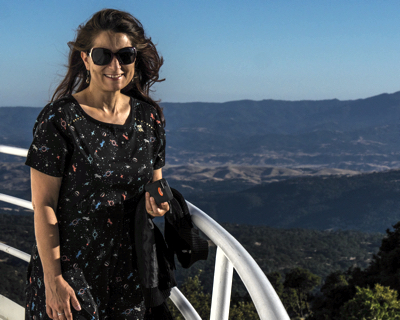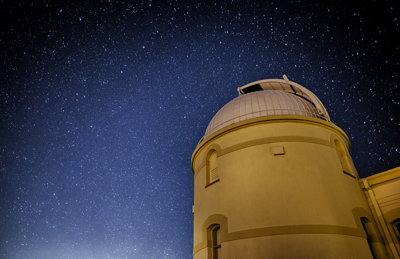Once the sun set on amateur astronomers enjoying solar flares from their tailgate parties atop Mt. Hamilton last weekend, scientists from NASA and University of California Observatories invited the public to peer into distant worlds. They announced new discoveries of potentially habitable earth-sized planets at the edge of what can be known.
If our galaxy, the Milky Way, was the size of the United States, one of these planets would be just a few minutes walk from here, said Natalie Batalha, a research astrophysicist for NASA Ames and project scientist for the exoplanet-finding Kepler Mission. It’s not, of course—the real size of the galaxy is estimated at between 100,000 and 200,000 light-years in diameter and the distance of one of these Earth-like planets is closer to 10 light-years or 60 trillion miles from the mountaintop.
Batalha, who earned her doctorate in astrophysics from UC Santa Cruz, was the keynote scientist on the second evening of the 37th annual Summer Series at the Lick Observatory on Mt. Hamilton, a popular evening program that includes Evening with the Stars on Fridays and Music of the Spheres on Saturdays. Both nights include astronomy lectures and views through the telescopes. Friday programs add lectures on the history of the observatory and its contributions while Saturday programs include live music and, for VIP ticket holders, a walking tour. Tickets for the event, which went on sale in April, sold out within hours.
For visitors, the evening started with a bit of history about the iconic facility, the first observatory built at high elevation that, for many years, harbored the biggest telescope of its kind. For decades it was the world center for observational astronomy.
On Saturday, VIPs joined a tour with resident astronomer Paul Lynam and Batalha, who was recently named by Time magazine as one of the world’s 100 most influential people. The group wound along the ridgetop home of several white, rounded observatory buildings and scientists’ dormitories. They toured the dome of the 3-meter Shane Telescope, the mountain’s largest telescope, and shared dinner before settling in for some live music. The White Album Ensemble, a popular Beatles cover band, sang “Lucy In The Sky With Diamonds” while the sun set over Silicon Valley.
After Batalha’s humbling, mind-bending astronomy talk, visitors were invited to peer at Jupiter through the 40-inch Nickel Reflector telescope and at Messier 5, a globular cluster visible through the historic 36-inch Great Lick Refractor telescope.
Observatory offers hands-on learning
Lick Observatory, atop 4,265-foot Mt. Hamilton, overlooks the east side of Silicon Valley. It is primarily a research and technology development facility and remains the premier UC training
observatory. It is operated by UCO with headquarters in the Interdisciplinary Sciences Building at UC Santa Cruz. UCO is also a managing partner of Keck Observatory in Hawaii, operates technical labs at UC Santa Cruz and UCLA, and is the center of UC participation in the multinational Thirty Meter Telescope project.
Student astronomers can use the equipment from a remote observation station at UC Santa Cruz, as well as from other stations throughout the UC system, and even from further afield such as Seoul, South Korea. Grad students are eligible to apply for telescope time as principal investigators. From afar, they gain valuable hands-on experience that is difficult to come by anywhere else. This year, UC Santa Cruz researchers have been scheduled to observe, using multiple telescopes and cameras, an average of 20 times per month.
“I’ve been able to get a lot of observing experience which is really difficult to get on some of the larger sized telescopes,” said Tiffany Hsyu, a third year UCSC doctoral student. Hsyu is using Lick telescopes remotely to confirm candidate dwarf galaxies that may offer insights into early conditions of the universe. “Every time I get to use a telescope I think, I’m one of just few people who get to do this. It’s pretty awesome.”
New UC Santa Cruz astronomy and astrophysics grad students make an inaugural pilgrimage to the mountain and enjoy an annual student campout atop the mountain as well.
A rich history of discovery connects UC Santa Cruz, a leading center for observational and theoretical research in astronomy and astrophysics, and the Lick Observatory. To name just a few groundbreaking discoveries with significant UC Santa Cruz leadership, there is the Automated Planet Finder instrument project headed by UCSC astronomer Steve Vogt; the major upgrade to the Kast Spectrograph at Lick Observatory, made possible in part through the fundraising work of Michael Bolte, a UCSC professor and former director of UCO; the development of new standards relating to the evolution of galaxies by Sandra Faber, a UCSC astronomy professor and former UCO director; and Laser Guide Star Adaptive Optics technologies, created by Claire Max, UCO director and UCSC astronomer.
Up to 200 astronomers are trained annually at Lick Observatory and about 40 scientific papers are published each year.
“We’re training the next generation of world-class scientists and instrument builders,” Lynam, said. “The other facilities are not training observatories. Lick Observatory gives students hands-on time to explore and also to tinker.”
The event kicked off NASA’s week-long Kepler conference during which Batalha and the Kepler team announced a catalog of planet candidates, 10 of which are near-Earth size and share several key characteristics that could potentially host microbial life.
Much stargazing also happens outside the observatories, thanks to amateur astronomers who are invited to set up their telescopes in the parking lot so visitors can glimpse into space. From one such telescope, viewers watched three moons circle Jupiter, making hundreds of millions of miles feel not quite so far away.
“I think Mr. (James) Lick would be very proud,” Lynam said, of the benefactor who set up a trust in the 1870s to build the world’s largest refracting telescope in 1888. It became operational in January 1888, 12 years after Lick’s death. A completed Lick observatory was donated to UC in June 1888.




